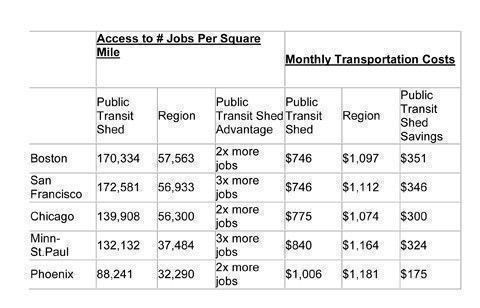 Location, location, location near public transportation may be the new real-estate mantra according to a new study released recently by the American Public Transportation Association (APTA) and the National Association of Realtors® (NAR). Data in the study reveals that during the last recession, residential property values performed 42 percent better on average if they were located near public transportation with high-frequency service.
Location, location, location near public transportation may be the new real-estate mantra according to a new study released recently by the American Public Transportation Association (APTA) and the National Association of Realtors® (NAR). Data in the study reveals that during the last recession, residential property values performed 42 percent better on average if they were located near public transportation with high-frequency service.
“When homes are located near public transportation, it is the equivalent of creating housing as desirable as beachfront property,” says APTA President and CEO Michael Melaniphy. “This study shows that consumers are choosing neighborhoods with high-frequency public transportation because it provides access to up to five times as many jobs per square mile as compared to other areas in a given region. Other attractive amenities in these neighborhoods include lower transportation costs, walkable areas and robust transportation choices.”
“Higher home values reflect greater market demand for areas near public transportation,” says NAR Chief Economist Lawrence Yun. “Transportation plays an important role in real estate and housing decisions, and the data suggests that residential real-estate near public transit will remain attractive to buyers going forward. A sound transportation system not only benefits individual property owners, but also creates the foundation for a community’s long-term economic well being.”
The study, The New Real-Estate Mantra: Location near Public Transportation, investigates how well residential properties located in a half-mile proximity to high-frequency public transportation or in the “public transit shed” have performed in holding their value during the recession compared to other properties in a given region.
While residential property values declined substantially between 2006 to 2011, properties close to public transit showed significantly stronger resiliency. The following are a few examples from the study: In Boston, residential property in the rapid transit area outperformed other properties in the region by an incredible 129 percent. In the Chicago public transit area home values performed 30 percent higher than the region; in San Francisco, 37 percent higher; Minneapolis-St Paul, 48 percent; and in Phoenix 37 percent higher.
The study looked at five regions, which illustrate the types of high-frequency public transit systems throughout the U.S. High-frequency public transportation includes subway (heavy rail), light rail and bus rapid transit. This sample accurately projects the nationwide average (42 percent) variance among properties located near high-frequency public transportation and those that are located further away from public transit.
The following table provides examples of the impact of high-frequency public transportation in the five study areas. Comparisons to the public transit shed versus the region show that the public transit shed provides access in some instances to more than three times more jobs per square mile as compared to other areas in a given region. (Note: not shown in the chart below but living near bus rapid transit in Boston resulted in access to five times more jobs per square mile compared to the region.) The table also illustrates that transportation costs are reduced by up to $351 a month for households residing in the public transit shed.

“Stable property values in areas with public transit access have a number of policy implications,” says Melaniphy. “As Congress and state and local governments look for ways to accelerate economic growth, this study shows that investing in public transportation is a boon to revitalizing our economy.”“When consumers choose a home, they also choose a lifestyle. Shorter commutes and more walkable neighborhoods matter to a growing number of people, especially those living in congested metro areas,” said Yun.
For more information, visit www.realtor.org.










